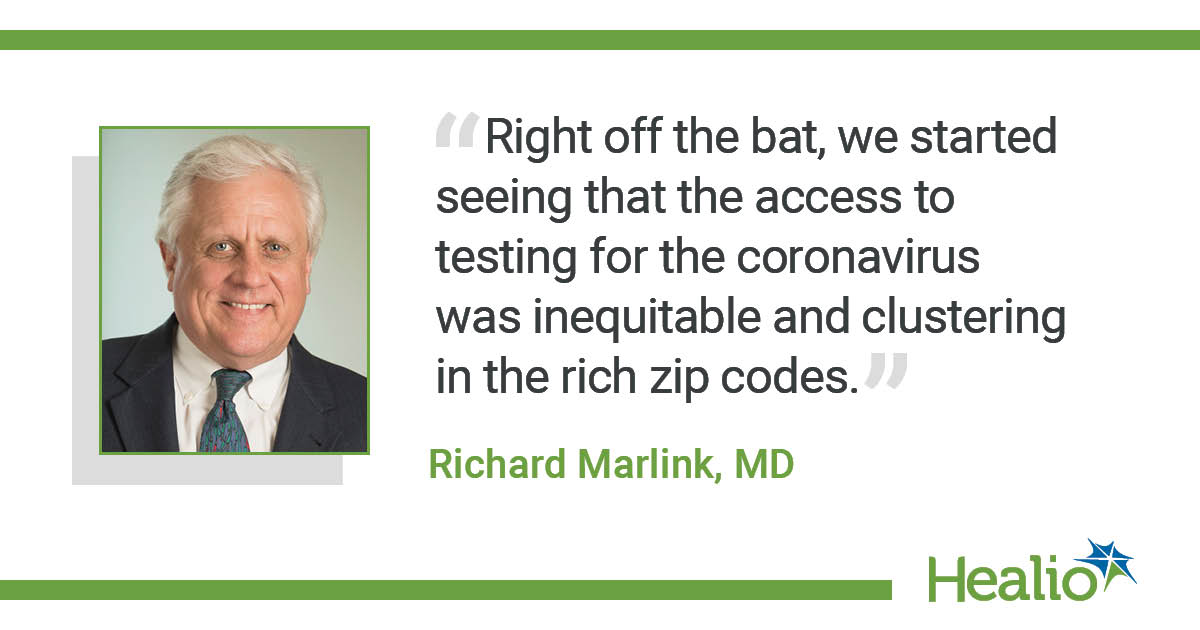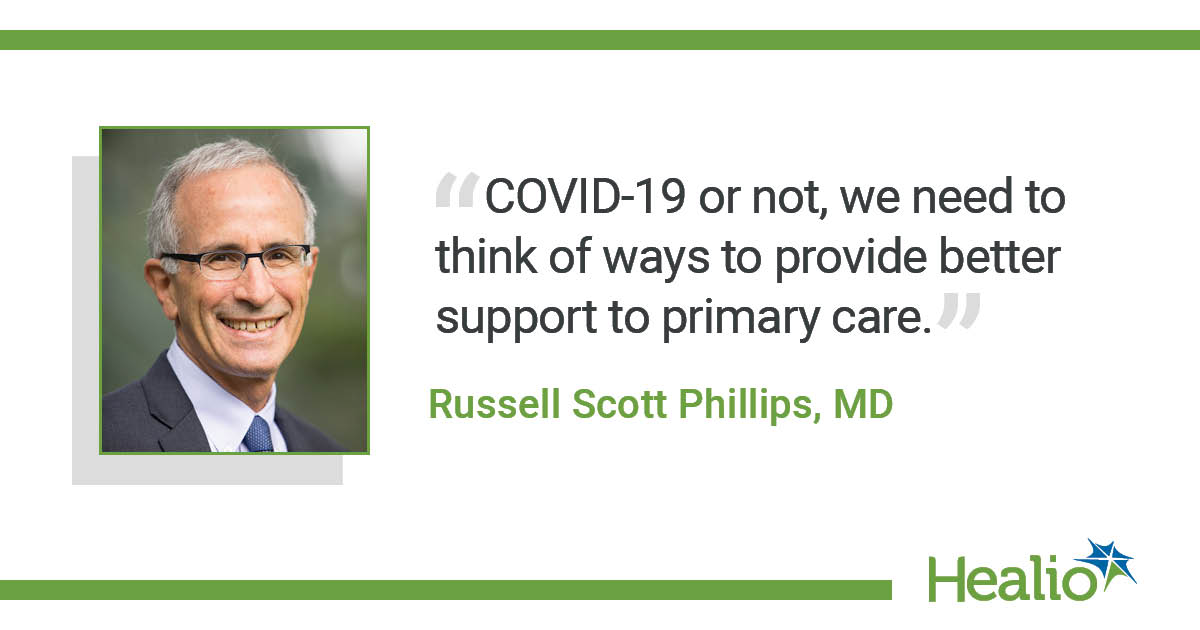COVID-19: Limited health care access further divides ‘haves’ from ‘have-nots’
Like most other aspects of health care in the United States, social determinants of health play a role in the COVID-19 pandemic.
Recently, a report released by the Federal Reserve found that in 2018, nearly 40% of people in the United States would not be able to afford an unexpected $400 expense.
“We’re seeing that most people are one pay check away from being not able to keep up with the basics like food or other essential supplies, so there are a lot of people out there who are really hurting and panicking now,” Richard Marlink, MD, director of the Rutgers Global Health Institute, told Healio Primary Care.
Marlink and Russell Scott Phillips, MD, director of the Harvard Medical School’s Center for Primary Care, spoke with Healio Primary Care about other ways in which social determinants of health are impacting patients during the COVID-19 pandemic.

Access to health care, testing
According to Marlink, current testing strategies are not reflecting the level of infection in poor communities.
“Right off the bat, we started seeing that the access to testing for the coronavirus was inequitable and clustering in the rich zip codes,” he said.
Although this should change as more tests become available, Marlink noted that individuals who are uninsured or undocumented may still be hesitant to seek testing due to the perceived costs.
In New York City, testing rates are higher in wealthier sections of the city but there are more ER visits for severe respiratory illness — a potential indicator of COVID-19 — in poorer sections, according to Marlink. Officials are using this information to better understand the prevalence of infection in low-income areas.
“Hopefully the testing will improve, but the access to health care is just going to be less for those who are poorer; that’s really the way our health care system is in the United States,” Marlink said, noting that the pandemic will continue to “widen the gap between the ‘haves’ and the ‘have-nots’ in terms of the access to care.”
Affordability of social distancing
Marlink explained that those with gig or low-paying jobs may not have health care benefits, preventing them from seeking care for COVID-19.
Phillips said that additionally, many of these patients “often don’t have the luxury of being able to work at home and avoid use of transportation and shelter in place, which has been shown to be the only really effective way of trying to avoid being exposed to [and] acquiring infection.”
Homeless people are at a particularly increased risk during the pandemic, as they do not have the option to stay at home and may face difficulties following other preventive guidelines like washing their hands, Marlink said. There is also an increase in food insecurity as many people find themselves unemployed. Food banks are struggling to meet the demand because volunteers are following stay-at-home orders. They are also “having trouble setting up in a world of social distancing,” as they find ways to establish food delivery in the communities and work to provide food while remaining 6-feet apart from each other, Marlink said.
COVID-19 and addiction
People with substance use disorder are also particularly affected by the pandemic, according to Nora D. Volkow, MD, director of the National Institute on Drug Abuse.
In a paper published in the Annals of Internal Medicine, Volkow explained the risk for severe COVID-19 increases with the presence of comorbidities like cancer, heart disease and respiratory conditions, many of which are present in smokers. Therefore, patients who smoke may be at an increased risk for severe illness or death from COVID-19.
Among those with opioid use disorder, Volkow wrote that “social distancing will increase the likelihood of opioid overdoses happening when there are no observers who can administer naloxone to reverse them and thus when they are more likely to result in fatalities.”
She also explained that people with substance use disorder who are trying to recover may struggle due to social distancing measures, as they are unable to engage in face-to-face meetings with peer support groups.
The prevalence of substance use disorder is high among people who are incarcerated or with housing instability, Volkow wrote. Therefore, many patients with substance use disorder are at a higher risk for infection due to their comorbidities, and as a result of increased COVID-19 transmission in prisons and in homeless shelters.
“Much is still unknown, but it can be expected that persons who smoke, vape or use certain drugs will be at increased risk for infection and its more severe consequences, and that strained health care systems and social distancing will present unique challenges to those with [substance use disorder],” Volkow wrote.
Rural communities
Although rural populations are typically more spread out, which could lower their risk for infection, Phillips highlighted potential challenges in these areas.
“I think people living in rural communities are likely to get together to go to church and do other activities as well,” he said. “We’re all social and enjoy getting together with other people, and unless there are clear restrictions that people are following everywhere, I think people who live rurally are potentially at a greater risk if people are not social distancing and avoiding being in crowds.”
Another potential health risk to rural communities is the threat of primary care practice closures. Recently, a national survey found 49% of primary care practices were severely impacted by the COVID-19 pandemic.
While larger practices are often protected by a large health network or hospital, Phillips said that small independent practices in rural communities rely on the income they generate to continue running. Because patients are postponing regularly scheduled visits during the pandemic, many small practices are struggling.

Phillips said he is hopeful that the government will view these primary care practices as small businesses and allow them to access the funding through the CARES Act. However, he noted that there have been numerous reports of practices having difficulties accessing these funds, so the government should “provide assistance and help to simplify the process so that there will be no barriers standing in the way of getting access to those dollars.”
He also noted that community health workers and social workers can help address social determinants of health in primary care practices, but many practices are unable to afford these resources.
“COVID-19 or not, we need to think of ways to provide better support to primary care,” he said. – by Erin Michael
References:
Federal Reserve. Report on the economic well-being of U.S. households in 2018. https://www.federalreserve.gov/publications/files/2018-report-economic-well-being-us-households-201905.pdf. Accessed Apr. 7, 2020.
Volkow ND. Ann Intern Med. 2020;doi:10.7326/M20-1212.
Disclosures: Marlink, Phillips and Volkow report no relevant financial disclosures.

